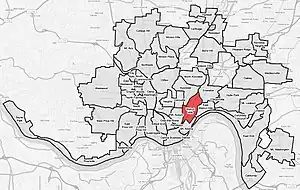Walnut Hills | |
|---|---|
.jpg.webp) Walnut Hills Branch Library | |
 Flag | |
 Walnut Hills (red) within Cincinnati, Ohio. | |
| Country | United States |
| State | Ohio |
| City | Cincinnati |
| Population (2020) | |
| • Total | 6,344 |
Walnut Hills is one of the 52 neighborhoods of Cincinnati, Ohio.[1][2] One of the city's oldest hilltop neighborhoods, it is a large diverse area on the near east side of Cincinnati. The population was 6,344 in the 2020 census.
History
The neighborhood was named from the farm of an early settler, Reverend James Kemper, which he called Walnut Hill.[3] For generations, the Kemper family lived in the Kemper Log House. Walnut Hills was annexed to the City of Cincinnati in September, 1869.[4]
After the turn of the century, new migrants from Cincinnati's downtown basin moved to the area. Like South Avondale, Walnut Hills was home to many Jewish and Italian families. An area on the western side of McMillan St. was known as “Little Italy.” After construction of the Union Terminal, and other public housing projects demolished housing in the West End, many African Americans moved to the area in the 1930s. When modern suburbs were created after World War II, many of community's middle class white residents moved out of Walnut Hills. Similarly, middle class African Americans moved from the area after less affluent residents moved to the area. Almost 80% of Walnut Hills was populated by African Americans by 1970.[5]
Historic Sites
Walnut Hills is home to multiple historic sites. The Harriet Beecher Stowe House was where Harriet Beecher Stowe and her family lived, as well as the site where she wrote Uncle Tom's Cabin.[6]
The Walnut Hills Library, Cincinnati's first Carnegie Library, and the Walnut Hills United Presbyterian Church's remaining tower at Taft and Gilbert were designed by architect Samuel Hannaford.[7]
The commercial district at Peebles' Corner, originally called Kemper's Corner, was once the busiest district outside Downtown Cincinnati, with six street cars lines intersecting at McMillan and Gilbert by the end of the 19th century.[8]
The original site of Walnut Hills High School is located in the neighborhood.[9]
Several historic districts in Walnut Hills have been listed on the National Register. These include the Gilbert-Sinton Historic District, Gilbert Row, and Peeble's Corner Historic District.
Demographics
| Year | Pop. | ±% |
|---|---|---|
| 1900 | 16,136 | — |
| 1910 | 18,018 | +11.7% |
| 1920 | 21,125 | +17.2% |
| 1930 | 21,545 | +2.0% |
| 1940 | 22,824 | +5.9% |
| 1950 | 23,369 | +2.4% |
| 1960 | 20,658 | −11.6% |
| 1970 | 14,049 | −32.0% |
| 1980 | 9,907 | −29.5% |
| 1990 | 8,917 | −10.0% |
| 2000 | 7,790 | −12.6% |
| 2010 | 6,495 | −16.6% |
| 2020 | 6,344 | −2.3% |
As of the census of 2020, there were 6,344 people living in the neighborhood. There were 4,223 housing units. The racial makeup of the neighborhood was 32.8% White, 60.1% Black or African American, 0.2% Native American, 1.4% Asian, 0.1% Pacific Islander, 0.8% from some other race, and 4.7% from two or more races. 2.4% of the population were Hispanic or Latino of any race.[10]
There were 3,777 households, out of which 32.6% were families. About 65.7% of all households were made up of individuals.[10]
12.7% of the neighborhood's population were under the age of 18, 71.8% were 18 to 64, and 15.5% were 65 years of age or older. 48.5% of the population were male and 51.5% were female.[10]
According to the U.S. Census American Community Survey, for the period 2016-2020 the estimated median annual income for a household in the neighborhood was $30,259. About 30.5% of family households were living below the poverty line. About 27.8% of adults had a bachelor's degree or higher.[10]
Notable People
- Harriet Beecher Stowe, author and abolitionist
See also
References
- ↑ U.S. Geological Survey Geographic Names Information System: Walnut Hills
- ↑ Ball, Jennifer (June 2007). "Selling Points". Cincinnati Magazine. p. 88. Retrieved 2013-05-06.
- ↑ Federal Writers' Project (1943). Cincinnati, a Guide to the Queen City and Its Neighbors. p. 283. ISBN 9781623760519. Retrieved 2013-05-04.
- ↑ Clarke, S. J. (1912). "Cincinnati, the Queen City, 1788-1912, Volume 2". The S. J. Clarke Publishing Company. p. 528. Retrieved 2013-05-20.
- ↑ Bicentennial Guide to Greater Cincinnati: A Portrait of Two Hundred Years. Ohio: Cincinnati Historical Society. 1988. pp. 173–174. ISBN 0911497080.
- ↑ "Harriet Beecher Stowe House - Home". Harriet Beecher Stowe House Website. Retrieved 2018-11-15.
- ↑ Ohio historic places dictionary (Vol. 2). Hamburg, MI: State History Publications LLC. 2008. ISBN 9781878592705.
- ↑ Walnut Hills City Neighborhood. Cincinnati Historical Society. 1983. p. 4.
- ↑ "Walnut Hills History". Walnut Hills High School. Retrieved 2018-11-15.
- 1 2 3 4 "Walnut Hills 2020 Statistical Neighborhood Approximation" (PDF). City of Cincinnati. Retrieved 1 January 2024.
39°07′37″N 84°29′03″W / 39.1269444°N 84.4841667°W
